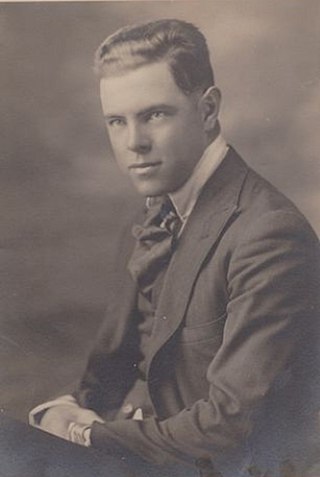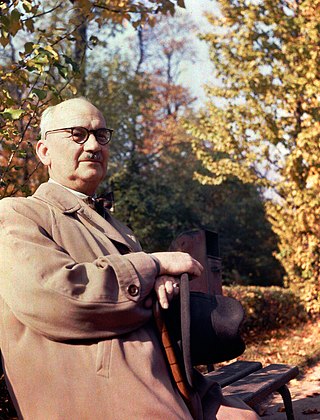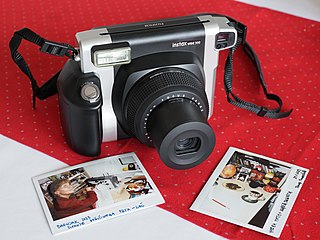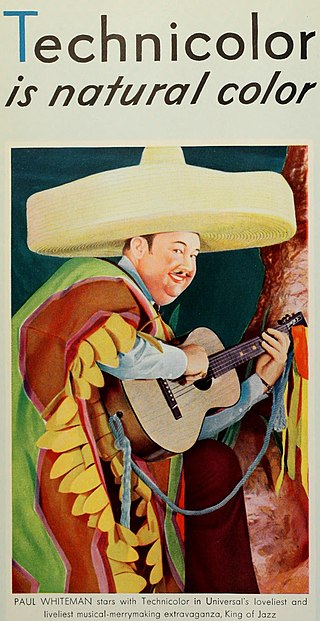The following list comprises significant milestones in the development of photography technology.

Polaroid was an American company best known for its instant film and cameras. The company was founded in 1937 by Edwin H. Land, to exploit the use of his Polaroid polarizing polymer. Land and Polaroid created the first instant camera, the Land Camera, in 1948.

The Land Camera is a model of self-developing film camera manufactured by Polaroid between 1948 and 1983. It is named after the inventor, American scientist Edwin Land, who developed a process for self-developing photography between 1943 and 1947. After Edwin Land's retirement from Polaroid in 1982, the name 'Land' was dropped from the camera name. The first commercially available model was the Model 95, which produced sepia-colored prints in about 1 minute. It was first sold to the public on November 26, 1948.

Kodachrome is the brand name for a color reversal film introduced by Eastman Kodak in 1935. It was one of the first successful color materials and was used for both cinematography and still photography. For many years, Kodachrome was widely used for professional color photography, especially for images intended for publication in print media.

Photographic processing or photographic development is the chemical means by which photographic film or paper is treated after photographic exposure to produce a negative or positive image. Photographic processing transforms the latent image into a visible image, makes this permanent and renders it insensitive to light.

An instant camera is a camera which uses self-developing film to create a chemically developed print shortly after taking the picture. Polaroid Corporation pioneered consumer-friendly instant cameras and film, and were followed by various other manufacturers.

In photography, reversal film or slide film is a type of photographic film that produces a positive image on a transparent base. Instead of negatives and prints, reversal film is processed to produce transparencies or diapositives. Reversal film is produced in various sizes, from 35 mm to roll film to 8×10 inch sheet film.
C-41 is a chromogenic color print film developing process introduced by Kodak in 1972, superseding the C-22 process. C-41, also known as CN-16 by Fuji, CNK-4 by Konica, and AP-70 by AGFA, is the most popular film process in use, with most photofinishing labs devoting at least one machine to this development process.

Instant film is a type of photographic film that was introduced by Polaroid Corporation to produce a visible image within minutes or seconds of the photograph's exposure. The film contains the chemicals needed for developing and fixing the photograph, and the camera exposes and initiates the developing process after a photo has been taken.
Ilfochrome is a dye destruction positive-to-positive photographic process used for the reproduction of film transparencies on photographic paper. The prints are made on a dimensionally stable polyester base as opposed to traditional paper base. Since it uses 13 layers of azo dyes sealed in a polyester base, the print will not fade, discolour, or deteriorate for an extended time. Accelerated aging tests conducted by Henry Wilhelm rated the process as producing prints which, framed under glass, would last for 29 years before color shifts could be detected. Characteristics of Ilfochrome prints are image clarity, color purity, and being an archival process able to produce critical accuracy to the original transparency.

The SX-70 is a folding single lens reflex Land camera which was produced by the Polaroid Corporation from 1972 to 1981.
Polaroid Type 55 film is a black-and-white peel-apart Polaroid film that yields both a positive print and a negative image that can be used to create enlargements.
A chromogenic print, also known as a C-print or C-type print, a silver halide print, or a dye coupler print, is a photographic print made from a color negative, transparency or digital image, and developed using a chromogenic process. They are composed of three layers of gelatin, each containing an emulsion of silver halide, which is used as a light-sensitive material, and a different dye coupler of subtractive color which together, when developed, form a full-color image.

Color motion picture film refers both to unexposed color photographic film in a format suitable for use in a motion picture camera, and to finished motion picture film, ready for use in a projector, which bears images in color.

Dufaycolor is an early British additive colour photographic film process, introduced for motion picture use in 1932 and for still photography in 1935. It was derived from Louis Dufay's Dioptichrome plates, a glass-based product for colour still photography, introduced in France in 1909. Both Dioptichrome and Dufaycolor worked on the same principles as the Autochrome process, but achieved their results using a layer of tiny colour filter elements arrayed in a regular geometric pattern, unlike Autochrome's random array of coloured starch grains. The manufacture of Dufaycolor film ended in the late 1950s.
In bipack color photography for motion pictures, two strips of black-and-white 35 mm film, running through the camera emulsion to emulsion, are used to record two regions of the color spectrum, for the purpose of ultimately printing the images, in complementary colors, superimposed on one strip of film. The result is a multicolored projection print that reproduces a useful but limited range of color by the subtractive color method. Bipack processes became commercially practical in the early 1910s when Kodak introduced duplitized film print stock, which facilitated making two-color prints.

Instax is a brand of instant still cameras and instant films marketed by Fujifilm.

Photographic film is a strip or sheet of transparent film base coated on one side with a gelatin emulsion containing microscopically small light-sensitive silver halide crystals. The sizes and other characteristics of the crystals determine the sensitivity, contrast, and resolution of the film.

Technicolor is a series of color motion picture processes, the first version dating back to 1916, and followed by improved versions over several decades.

Polaroid B.V. is a Dutch photography and consumer electronics company, founded as a manufacturer of discontinued film for Polaroid Corporation instant cameras. The company specialises in restoring and selling new instant cameras under the Polaroid brand name as well as television sets and wireless speakers.












